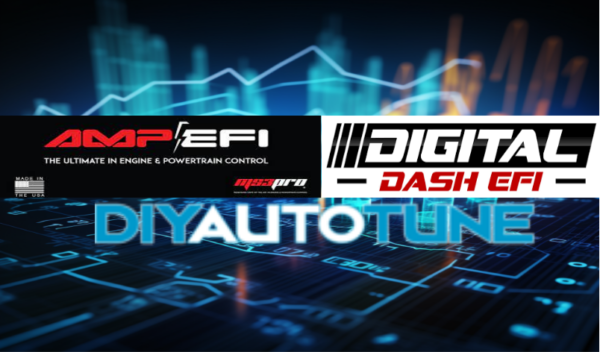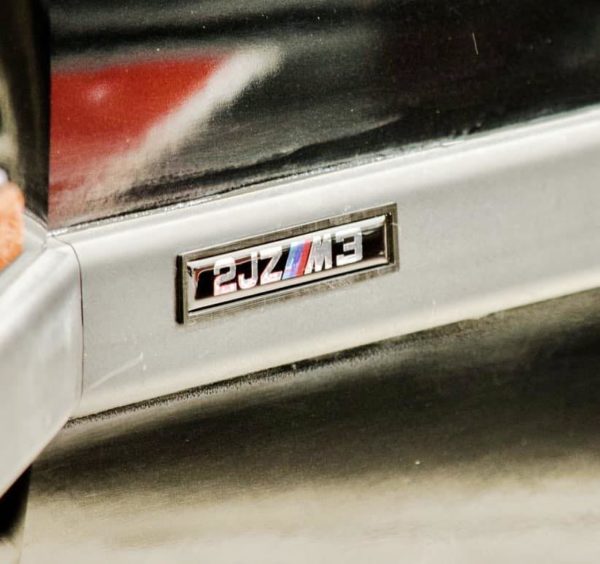The automotive electric fuel pump is at the core of every modern fuel injection system. Especially when upgrading to standalone fuel management, like the MS3X or one of the MS3Pro PNP units. This powerhouse device is responsible for drawing fuel from the tank and delivering it to the engine with precision. By maintaining a consistent and reliable fuel supply, these pumps, along with the related plumbing, wiring, and control ensure you ALWAYS have power on demand!
Plumbing Perfection: Ensuring Seamless Fuel Flow
Proper plumbing is the lifeline that ensures fuel travels seamlessly from the tank to the engine. The choice of plumbing materials and design can significantly impact the overall efficiency of the fuel delivery system. A good rule of thumb when choosing fuel line size according to Summit Racing. ( supply and return size ):
- Up to 350hp 5/16″ or -5AN
- 350 to 450hp 3/8″ or -6AN
- 450 to 650hp 1/2″ or -8AN
- 650 to 1000hp 5/8″ or -10AN
*Reminder, When using E85 step up to at least the next larger size in all of your pumps, lines, and fittings, as the flow requirements for alcohol are quite a bit more than gasoline.
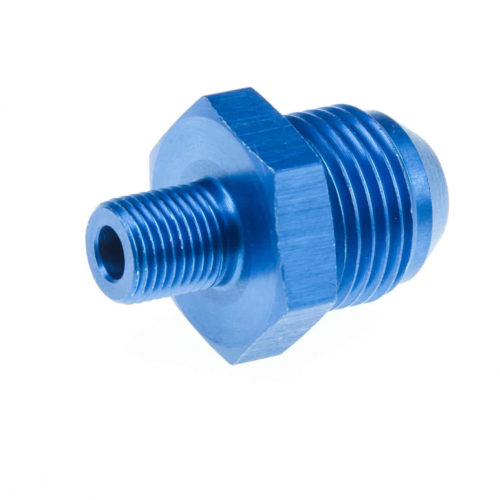
When selecting plumbing components, opt for high-quality materials like stainless steel, racecar-quality flexible hose, or high-grade plastic. These materials need to exhibit excellent resistance to corrosion, and abrasion which is crucial considering the exposure to fuel and potential contaminants. Stainless steel, in particular, is known for its durability and ability to withstand harsh conditions.
Not only do the lines and/or hoses need to be properly sized, and of the proper materials, but we also need to consider any fittings that might be involved. Anywhere you need to add a connection to a filter, pump, fuel pressure regulator, or pass through a bulkhead these connections are crucial. Only use properly rated fittings for the pressure, generally 40 – 80 psi or more. Make sure crimps or clamps are capable of dealing with those pressures and are not going to corrode, loosen, or damage the fuel lines. Ready-made fuel system kits like those offered by Summit can be a great solution to ensure all of your fuel system components play nicely together.
Avoiding Obstacles
Moreover, the design and layout of the plumbing system play a vital role in maintaining optimal fuel flow. Minimize the number of bends and restrictions in the plumbing pathway to prevent any hindrance to the fuel’s journey. Straight, unobstructed lines enable fuel to move freely, reducing the chances of pressure drops or inefficiencies. NEVER run your fuel lines through suspension components, under frame rails or control arms, near spinning prop shafts, or against hot exhaust. These tips may sound like common sense, but trust me I’ve seen some CRAZY things! Keep in mind, that just because the suspension or steering doesn’t interfere when the car is on the lift, or sitting statically there won’t be interference under hard launches or high-g cornering. Take any body movement or suspension travel into account when routing fuel lines to and from the tank.
Also, consider incorporating fuel filters within the plumbing system. Ideally before and after the fuel pump. 100 microns before the pump and the next size smaller afterward at minimum. Be sure and select only high-quality components rated for the pressures that your fuel system is going to see. These components help ensure that only clean fuel reaches the engine, preventing clogs and enhancing performance. Regular inspections and maintenance of the plumbing system will go a long way in preserving its efficiency and extending its lifespan.
Wiring Your Pump Wisely
Efficient wiring is the nervous system that enables the fuel pump to function optimally. Quality wiring not only guarantees a stable power supply but also safeguards against potential short circuits or voltage drops.
And, just like when it comes to correct sizing on the plumbing side, it’s equally important to think about sizing on the electrical side. Some of these large high-performance fuel pumps can easily draw more than 20 amps. This is definitely something to consider when upgrading from the OEM pump. The stock power supply or ground wiring may not be up to the task. ALWAYS, ALWAYS, ALWAYS use appropriately sized wiring, fuses, and relays. ( For a guide on using your MegaSquirt ECU for relay control see here ). Take note in the following graphs of how voltage can affect the flow rate of our pumps. Voltage drop and high resistance can be a death blow to our fuel supply system.
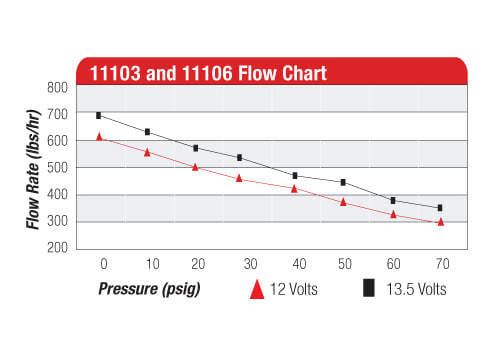
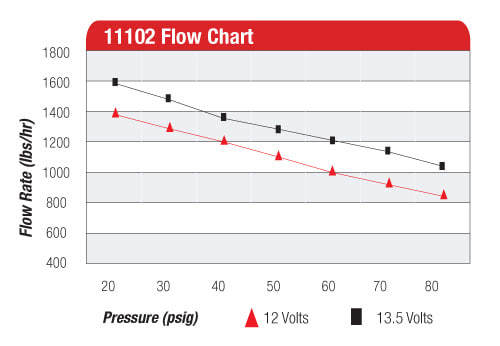
To enhance the durability of the wiring, consider using automotive-grade wiring looms or conduits to protect the wires from environmental factors. Keep your wiring not only away from obvious sources of heat, but also from moving suspension components, driveshafts, and anything else that could potentially damage your harness. Additionally, incorporate secure connectors and terminals to establish reliable connections that won’t loosen over time due to vibrations or other stresses.
Proper Fuel Pump Sizing: Choosing the Correct Size
Selecting the right size of an automotive electric fuel pump is essential for optimal performance. The pump’s size is determined by factors such as the engine’s horsepower, the fuel demand, and the intended use of the vehicle. A pump that’s too small may struggle to deliver the required amount of fuel, leading to engine performance issues, while an oversized pump can lead to excessive fuel consumption and unnecessary strain on the electrical system.
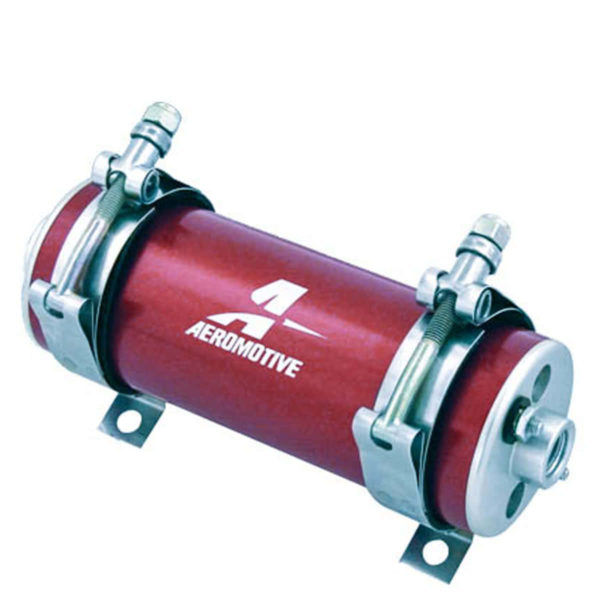
To choose the correct size, start by calculating the engine’s maximum fuel consumption in liters per hour (LPH) or gallons per hour (GPH). This value will give you an idea of the pump’s flow rate requirement. Match this requirement with a pump that offers slightly more capacity to ensure sufficient fuel delivery, especially during peak demand.
Some Math Involved
To do this we need to do a little math. Fuel Demand in Lbs/Hr = HP x BSFC. To measure needed fuel in Lbs/Hr we need to estimate the engine’s BSFC or Brake Specific Fuel Consumption. This is a measurement of how much fuel that engine requires at full power. For naturally aspirated engines, something around 0.5, and turbo/supercharged engines will be about 0.6. Once we know this, let’s make a realistic target horsepower estimate. So for this example let’s use 500hp NA with a BSFC of 0.5
500 x 0.5 = 250 Lbs/Hr fuel requirement.
To find Gallons Per Hour we divide by 6, as a gallon of gasoline weighs approximately 6lbs.
250 lbs/hr / 6 = 41.67 gallons/hour.
For Liters per Hour, we divide by 1.6
250 lbs/hr / 1.6 = 156.25 liters/hour
Keep in mind this is a starting point working from an estimate. However, it can be great for finding the “range” your combination is likely to work in. Most manufacturers of quality fuel components will provide measurements in one of these three ways. Lbs/Hr, G/Hr, or L/Hr.
Best Practices for Maximum Gains
Installing an automotive electric fuel pump involves a series of precise steps to ensure peak performance. Begin by selecting a suitable location within the fuel tank for the pump. This location should promote efficient fuel pickup and prevent cavitation. Follow the manufacturer’s guidelines for installation depth and orientation. When securing the pump, utilize rubber isolators to reduce vibrations and noise. Also, be sure and mount external pumps BELOW the fuel source, as they operate better when gravity-fed fuel as opposed to trying to suck it out of the tank or cell.
Maintenance Matters: Prolonging Pump Longevity
To reap the benefits of an optimized fuel delivery system, regular maintenance is crucial. Inspect the plumbing for any signs of leaks, cracks, or wear. Check the wiring connections for tightness and security. Periodically test the pump’s performance and pressure output to ensure it meets the required specifications. By staying proactive with maintenance, you’ll extend the lifespan of your automotive electric fuel pump and enjoy consistent performance.
Conclusion
From selecting the right automotive electric fuel pump to meticulously planning the plumbing and wiring, every step contributes to a well-optimized system. Electric fuel pumps, plumbing, and wiring form the backbone of an efficient fuel delivery system. By understanding their significance and implementing best practices, you can experience improved performance, safety, and overall reliability. Remember, every component plays a vital role in the symphony of your vehicle’s performance – a symphony that can be harmonized through meticulous planning and execution.
